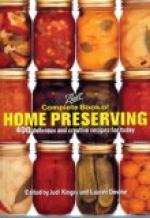Belfast, Ireland, is the home of linen and damask. There are manufactories in both Scotland and France, but it is in Belfast that the fabric attains to the highest perfection, and “Irish linen” has come to be synonymous with excellence of design and weaving and luster—a most desirable trilogy. The prospective purchaser of table linen should go to her task fortified with some information on the subject, that she may not find herself totally at the mercy of the salesman, who often knows little about his line of goods beyond their prices. First of all she will probably he asked whether she prefers bleached or unbleached damask. The latter—called “half-bleach” in trade vernacular—is made in Scotland and comes in cheap and medium grades alone. Though it lacks the choiceness of design and the beauty and fineness of the Belfast bleached linens, it is good for everyday wear and quickly whitens when laid in the sun on grass or snow; while the fact that its cost is somewhat less than that of the corresponding quality in the bleached damask, and that it wears better, recommends it to many. Occasionally the chemicals used in the bleaching process are made overstrong to hasten whitening, with the result that the fibers rot after a while and little cut-like cracks appear in the fabric. This is not usual, but of course the unbleached damask precludes all possibility of such an occurrence. One firm in Belfast still conscientiously employs the old grass-and-sun system of bleaching, and their damask is plainly marked “Old Bleach.” The half-bleach is sold both by the yard and in patterns.
DAMASK
Damask, by the way, takes its name from the city of Damascus where the fabric was first made, and is simply “linen so woven that a pattern is produced by the different directions of the thread,” plain damask being the same fabric, but unfigured. The expression “double damask” need occasion no alarm; it does not imply double cost, a double cloth, or double anything except a double, or duplicate, design, produced by the introduction of an extra thread so woven in that the figure appears exactly the same on both sides of the cloth, making it reversible.
QUALITY
The next thing will be to decide between buying by the yard and buying a pattern cloth in which the border continues without a break all the way around, adding about ten per cent to the price. The designs in both cloths are the same in corresponding qualities. We are knights and ladies of the round table these days, and cloths woven specially for use thereon, with an all-round center design, come only in patterns. Cloths of this description are used also on square tables, as the wreath effect is very decorative. As to the quality of damask, it depends not so much upon weight—for the finest cloths are by no means the heaviest—as upon the size of the threads and the closeness and firmness with which they are woven. Avoid the loosely woven fabric; it will neither wear nor look so well as the one in which the threads are more compact. In the better damasks the threads are smoother and finer in finish.




